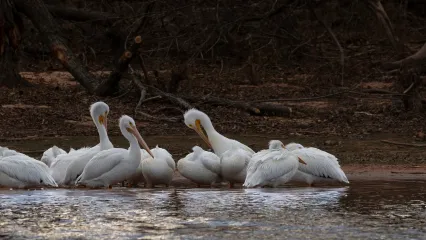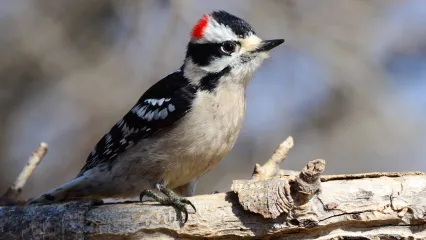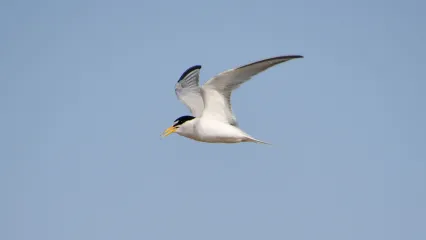
Description
One of eight known species of pelicans, the American white pelican (Pelecanus erythrorhynchus) is one of the most recognizable birds. The most notable feature of the American white pelican is its unmistakable, large pouched bill. These birds are often found in large flocks on reservoirs and rivers across most of Oklahoma during migration south from early September to November, and back north from early February to May.
Adult white pelicans are often mistaken for snow geese, swans or whooping cranes by the novice birder. Their distinct black primary and outer secondary feathers are sure indicators as to what they are. Upon closer inspection, observers will see a tucked neck, and orange bill, legs and feet. Another distinguishing characteristic is their plump bodies, which give them an altogether different profile than other birds.
In 1838, John James Audubon specifically included the word "American" in this bird's name. In writing about the naming of this species, he said, "In consequence of this discovery, I have honored it with the name of my beloved country, over the mighty streams of which may this splendid bird wander free and unmolested to the most distant times, as it has already done in the misty ages of unknown antiquity."
With internal air sacks beneath the skin and in the bones, pelicans are incredibly buoyant. White pelicans fish in groups floating atop the water. They often work together in flocks to use their feet and wings to corral fish. Instead of diving, they simply dip their heads below the surface to troll for rough fish such as gizzard shad. They scoop up the fish in their elastic bill pouch, which can hold several gallons of water at one time. Most feeding takes place during the early morning and early evening hours. An average pelican will eat 3 to 4 pounds of fish daily.
While abundant today, the American pelican population declined noticeably in the 1960s because of pesticides such as DDT. This pesticide contamination caused eggs to become thin-shelled and break under the weight of the parent, causing the species to suffer. DDT was banned in 1973 after alarming declines were observed among pelicans and other species. Populations had rebounded by the 1980s. White pelicans are now listed as a Species of Least Concern, but the birds remain protected under the Migratory Bird Treaty Act in the United States.
Size
The pelican is among the largest of North America's birds, weighing an average of 16 pounds with an impressive 9- to 10-foot wingspan.
Habitat
Pelicans nest In colonies on sandbars, islands, and peninsulas in remote, undisturbed areas. Their breeding range extends from the prairies of Canada into the mountain states, to the Gulf Coast of Texas and Mexico. Preferred nesting habitats are islands, especially those associated with freshwater lakes. They forage primarily in shallow lakes, marshlands and rivers.
Life Cycle
Nests are built as ground depressions lined with dried vegetation. Pelicans lay an average of two eggs and incubate them using their feet since they don't have the typical "brood patch" of bare skin on the belly. White pelican chicks hatch helpless, with homely, orange skin. They eat by digging digested food out of the adult's pouch. As chicks mature, they join a "pod" or "gang" and feed in large groups until they are ready to fly at about 10 weeks of age.
How To Observe
Awkward on land, the American white pelican makes up for that minor flaw by being adept in the water and in the sky. In flight, the birds usually glide together in large groups, with their necks folded against their shoulders. Observers can easily become mesmerized watching these large groups of white pelicans as they ride the heat thermals on clear days. When flying, they seem to soar in unison, each bird flapping its wings at the same time while circling ever so higher. They are truly amazing bird to watch in flight.
Each September, birders flock to the Salt Plains National Wildlife Refuge to participate in a weeklong Pelican Celebration. About 50,000 white pelicans stop over at the Salt Plains to rest during their fall migration. There is also an annual Pelican Festival in late September in Grov:1 "celebrating the American white pelican's return to Grand Lake.


